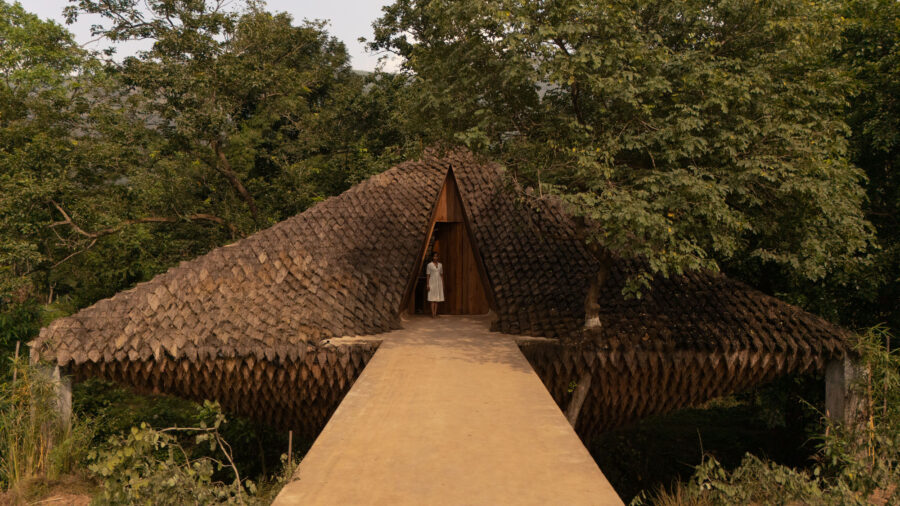
CULTURE


© 方舟
中国の杭州に建つ〈「倉庫の中の倉庫」展示・メディアセンター(”Warehouse within a Warehouse” Exhibition Center and Media)〉は、軍事倉庫と言う貯蔵目的の空間を改修し、”モノ”を魅せる展示空間へと転換したプロジェクトです。
古い倉庫の中に新たな家形の空間を挿した建築となっており、あえて軸をずらし、古い構造体の複雑な接合部を新たな構造により囲い、フレーミングすることにより新旧どちらの要素も際立たせています。中国の設計事務所 レイ&エミリオ・スタジオ(Ray&Emilio studio)が設計した、近年、海外建築業界で注目を集めている、歴史的な建築物を保存するだけでなく現代に適合させ活用する「アダプティブリユース」という考え方を取り入れた建築です。
(以下、Ray&Emilio studioから提供されたプレスキットのテキストの抄訳)

© 方舟

© 方舟
このメディアセンターは、古い工業ビルのリノベーション・プロジェクトである。杭州の旧市街地である饅頭山に位置する廃墟と化した18号軍事倉庫を、インダストリアルデザイン製品の展示ホール兼メディアリリースセンターに生まれ変わらせた。
所有者であるBo Le Designは、革新的な工業製品の展示、小規模なアート展の開催、業界における新製品の季節ごとのリリース、アート関係の講演会など、さまざまなニーズに応えることを目的とした、高い影響力をもつ工業デザイン企業である。

© 方舟
古い倉庫の歴史と改修の痕跡を活かす新たな空間
この空間に初めて足を踏み入れると、木造の構造体に支えられた勾配屋根に目を奪われる。この倉庫は以前にも一度、改修工事が行われており、屋根の棟の真ん中にガラス屋根が設置され、内部に非常に豊富な天空光が入るようになっていた。
私たちは、古い軍事倉庫としての歴史と改修の痕跡という、既存の空間がもつ空間的な魅力を深く掘り下げながら、木造建築がもつ力強さをより強調し、天窓から差し込む自然光を存分に活用することで、工業製品の展示や新商品の発表に特化した個性的な内部空間を創出することとした。

© 方舟

© 方舟
貯蔵のための倉庫から”モノ”を魅せる展示空間への転換
また、「仓中仓(中国語で倉庫の中の倉庫)」という名前は、「仓」という言葉そのものの魅力に由来している。
倉庫は居住よりも貯蔵に重点を置いており、伝統的な住宅では妻面に入口を設けることはほとんどないが、倉庫では可能なため、西洋のバシリカのような純粋な奥行きのある空間とすることができる

© 方舟

© 方舟
私たちは「古い倉庫」の中の「新しい倉庫」が、「倉庫」の本質的な特徴と空間の奥行きを強化する、新しいタイプのバシリカであることを願っている。そのため、空間の奥行きを強調するために、あえて区画の位置をずらすことで、空間の無限の広がり感を高めている。
倉庫はもともと保管を目的としていたが、改修後はモノを展示する場所としてだけでなく、工業製品の本物の特性、すなわち “モノ “としての性質を際立たせている。その価値は、モノを創造し、心と手が一体となった状態を通して魂を吹き込み、さらなる価値を与えることにある。
これは、私たちがこの空間を創造するために行ったプロセスと類似している。つまり、急激な変化を与えるのではなく、本来の空間的価値を掘り起こし、魂を吹き込むような建築なのである。

© 方舟
既存の部分も新たな部分も際立たせる光と構成の相互作用
「古い倉庫」の中の「新しい倉庫」の関係はダイナミックなものとなっている。単なる容積的な封じ込めにとどまらず、私たちのデザインは、この2つの構造が相互に作用することを目指した。
対比や融合だけにとどまらず、2つの構造がある地点で交わることで、新旧の要素の相互作用から生まれる複雑な絡み合いを期待している。

© 方舟
新たに形成された勾配屋根を含む「新しい倉庫」の構造が、既存の複雑な接合部を囲むことで効果的なフレーミング装置として機能する。これにより来場者の構造的な複雑さへの認識を高め、古い構造体が上から下へ降りていく一方で、新しい構造体は下から上へ上がっていく。
この相互作用は、建築という物理的なものだけにとどまらない。空間のあちこちにある天窓から自然光が下方に流れ落ちる一方で、新しい部分に沿って設置された人工照明は上方に光を発する。
自然照明と人工照明が交差することで、フレーミングとは違うもう1つの相互作用のレイヤーを形成している。

© 方舟
「倉庫」の中では、構造的な包みの階層的な関係が徐々に展開していく。
展示エリアには「新しい倉庫」に開口部が設けられており、既存の建物の窓とつながることで内部空間に自然光と外の風景を取り込んでいる。これにより正と負の形が絶えず絡み合い、探索中に意図せず遭遇する視覚的な手がかりへと来場者の注意を導く。

© 方舟
「新しい倉庫」の屋根勾配に沿って立体的な劇場が形成されており、この劇場空間での工業新製品の発表のほとんどのニーズを満たすことができる。
この劇場で異なる高さを知覚することで、来場者はこの構造の背後に潜む可能性をより深く認識し、屋根勾配の変化を感じ取る。この知覚の過程で、「新しい倉庫」がシンプルな形でありながら、機能的な用途やヴォイドの空間と密接に関係していることが次第に明らかになっていく。

© 方舟

© 方舟

© 方舟

© 方舟

© 方舟

© 方舟

Top view

Plan

Section
以下、Ray&Emilio studioのリリース(英文)です。
The “Warehouse within a Warehouse” Media Center
Design by: Ray&Emilio studioThe “Warehouse within a Warehouse” Media Center is a renovation project of an old industrial building. Located in Mantoushan, the old city area of Hangzhou, it involves transforming an abandoned No. 18 military supply warehouse into an industrial design product exhibition hall and media release center. The owner, Bo Le Design, is a highly influential industrial design company that aims to meet various needs such as showcasing innovative industrial products, hosting small art exhibitions, seasonal releases of new products in the industry, and artistic lectures.
Upon entering this space for the first time, one’s eyes are drawn to the sloping roof supported by wooden structures with direct and efficient triangular connections forming intersecting relationships throughout. The warehouse had previously undergone renovations with a glass roof installed at its ridge allowing ample natural light inside. We hope to preserve complete information about this place: its historical significance as an old military warehouse and traces left behind after transformation. This requires us to deeply explore the unique spatial charm of the original site while enhancing the sense of strength inherent in these wooden structures and fully utilizing natural light introduced through skylights—creating a distinct internal space tailored specifically for displaying industrial products or launching new ones.
Naming it “Warehouse within a Warehouse” also stems from our fascination with this word itself—the top part represents structure while middle signifies entrance; we can see from its structural composition that “warehouse” truly embodies authenticity when compared against traditional residential buildings where entry rarely occurs via gable walls but warehouses allow for such access instead—a pure vertical depth similar to Western basilicas formed directly by their underlying structure components.
We envision creating something entirely novel—an updated version akin to Brazilian Basilica architecture—that strengthens essential characteristics associated with warehousing spaces including heightened perception towards their profound depths achieved through segmental displacement techniques emphasizing layered dimensions extending infinitely into space.
Warehouses were originally meant for storage purposes; however post-renovation they serve not only as places exhibiting objects but highlight authentic attributes of industrial products—namely, their nature as “objects.” The value lies in creation and imbuing objects with soul through a state where heart and hand are unified, granting them additional worth. This parallels the process we undertook to create this space—a construction that unearths its original spatial value while endowing it with spirit rather than making abrupt changes.
The relationship between the “new warehouse” within the “old warehouse” is dynamic. It goes beyond mere containment on a volumetric level; our design aims for an interplay between these two structures. We hope they intersect at certain points instead of being limited to contrast or fusion alone—an intricate entanglement resulting from interactions between new and old elements. Thus, we extended the structure of the “new warehouse,” including its newly formed sloping rooflines upwards by selecting complex junctions among existing components below—the new ridge section encloses intersections created by older structures effectively serving as framing devices—to enhance people’s perception towards structural complexity. While old structures descend from top downwards, new ones rise up from bottom creating an entirely fresh dialogue in-between regions.
This interplay isn’t confined solely within physical architecture; due to skylights present throughout spaces naturally lit cascades downward whereas artificial lighting installed along newer sections emanates upward forming another layer of intersectional selection alongside natural light sources.
A hierarchical relationship encapsulated by “warehouse” unfolds gradually: As layers decrease structurally speaking,the most densely packed display area emerges enveloping outermost parts connecting windows found in pre-existing buildings via openings designed specifically for admitting light into interior spaces—this constant transformation creates positive-negative exchanges guiding observers’ attention toward subtle visual cues unintentionally encountered during exploration—we aim for visitors’ experience inside this space to be both dynamic and continuous.
Following suit with inclined roofs shaped like Chinese character ‘仓’,a three-dimensional roadshow theater forms naturally—one row after another arranged according to roof slope allowing individuals to situate themselves along this gradient—this theater space caters well to the majority of industrial product launches. As people perceive different heights, they become more acutely aware of potential hidden behind these structures and experience roof slope variations in diverse physical conditions; during this process, it gradually becomes clear that although the new ‘仓’ structure appears simple on its surface,it is closely related to functional usage,cavity spaces,and other vital aspects.
Project Information
Name: “Warehouse within a Warehouse” Exhibition Center and Media
Release Center Design: Ray&Emilio studio
Location: Fenghuangshanjiaolu, Xihu District, Hangzhou City
Lead Architects: Fang Runwu,Wang Minghao
Design Team: Fang Runwu,Wang Minghao,Ma Zhichao,Xu Dawei,Li Jianchao,Wu Chengxun,Li Shubo,Zheng Fengwen
Owne: Bo Le Industrial Design Co., Ltd.
Construction Company: Baigu Construction Group
Timeframe: October 2023
Photographer: FANG Ark Texts by Wang Ming Hao,Fanng run wu









